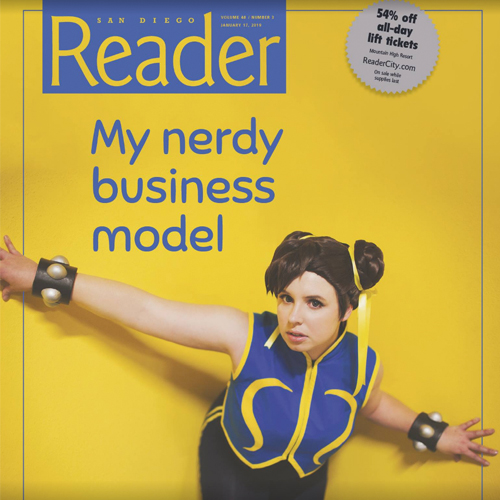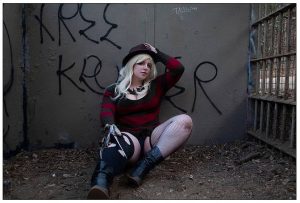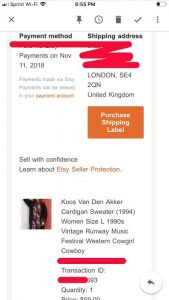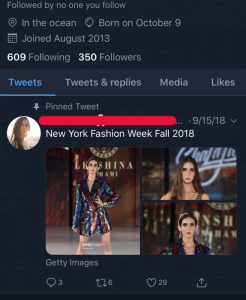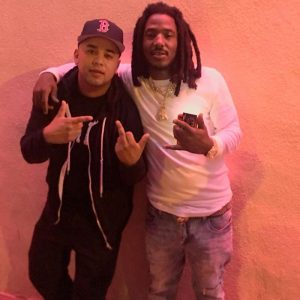San Diego millennials show their nerdy business models
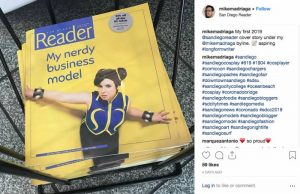
Original story featured in the print edition of the San Diego Reader (January 17, 2019)
Nikki from Lemon Grove makes money in not-so-orthodox methods. “I’ve had a few people come to me that have giant fetishes,” she says, “which is basically the idea of a giant woman stepping on, eating, or messing with very tiny people. Think the movie Honey, I Shrunk the Kids. Folks have contacted me to make photos like that, just in normal not revealing clothes. I have to say that I’ve done it, because it’s easy money even if it is a bit weird, and people inform me that they pleasure themselves to just my normal photos on the regular, so with something like that where I make some extra money and I’m still able to keep covered and not do anything sexual — I’m probably going to take them up on the offer.”
I get it …. sort of. Back in the 1990s, Baby Boomers and my fellow gen-xers doubted and mocked my “nerdy” business model, which ran on a 28,800 speed modem. To sustain myself while attending Mesa College in the mid-to-late 1990s, I bought and sold comics, toys, and Magic: the Gathering cards at the San Diego Comic-Con and online. I embraced the world wide web, as we called the internet then, and began selling on the America Online (AOL) forums in 1996. I opened my first eBay account in 1997.
I did OK during those times …. until a few years later, when social network platforms like Friendster, Myspace, and hi5 became viral distractions for our online customers.
In 2006, I saw a major drop in my online sales and it worsened as the recession neared. Then in 2009, my online business picked up, but for other online-sellers that were hip to using their Twitter, YouTube, and Facebook accounts to draw customers back to their point of sale pages — their businesses “made bank.” Many of the new sellers-turned-brand owners who made oodles of money because of their social media savviness — are millennials, including: Khloe Kardashian, 34; Michelle Phan 31; and Amber Venz, 31. Then there’s post-millennial Kylie Jenner, who was born around the same time that I opened my first eBay account. Jenner, 21 is reportedly close to being a billionaire, due to the success of her Kylie Cosmetics line and brand endorsements.
According to the Pew Research Center, “anyone born between 1981 and 1996 (ages 23 to 38 in 2019) will be considered a ‘Millennial,’ (Generation Y) and anyone born from 1997 onward will be part of a new generation (Generation Z).”
Since August, I’ve spoken to a few Generation Y-and-Z San Diegans who are utilizing online platforms and apps to market themselves and generate income in unorthodox manners…. as I did 20 years ago.
Twitter doesn’t suck
Nikki, 28, is a motion graphics artist-and-animator by trade; she’s also a professional cosplayer.
Cosplay — a combination of the words “costume” and “play” — is an artistic activity in which the participants, called cosplayers, dress in (often self-made) costumes and accessories to mimic a specific character.
On Nikki’s Instagram photo gallery, where she goes by the Piggy Nukka moniker, she cosplays as a sexy version of Freddy Krueger from the Nightmare of Elm Street franchise, and as Chun Li from the Street Fighter video game series. She’s gained over 12,000 followers on Instagram, but prefers Twitter, where she has over 13,000 followers.
“Social media presence matters a lot, since it is basically free advertising,” she says. “Small creators like myself can’t afford to run ads. I’m very lucky that I was able to create a bit of a presence before a lot of the big name websites started cutting the reach of profiles.”
On December 18, 2018, she tweeted: “I hope Twitter never starts to suck like Facebook” — on which she has over 20,000 followers — “and Instagram, or I will perish.”
She says that on Twitter, her “reach isn’t drowned by algorithms” (unlike other platforms) — and she can direct potential clients to her personal email for paid commissions, or to her Patreon account to support her content.
Patreon is a point-of-sale/social-media website where fans can pledge monthly — via an attached credit card or online payment system like Paypal — to creators or artists, in exchange for rewards.
On Patreon, I found another female cosplayer from San Diego who offered a $1000-per-month pledge package, which included in part: various prints and a large poster of herself (kissed and signed), access to a private Snapchat with her, a social media follow…. and a Google Hangout once a month. Hangout is a social and communication platform that “brings conversations to life with photos, emojis, and even group video calls for free.” She had nine patrons on her Patreon account, and when I emailed her with interview questions, she didn’t respond.
Nikki, on the other hand, returned my email after a couple of days.
As of December, Nikki makes $547 per month on Patreon and has 139 patrons. She has a $3-per-month package on the site, which includes: a full HD photoshoot pictorial sent via zip file, an animated cosplay GIF of herself, and access to exclusive and previous videos, commentaries, podcasts, and photoshoots. Also for December, she offered $10 and $18 polaroids to her patrons which sold out immediately as indicated by the product counter within the ad.
“Right now, I utilize my Patreon as a free blog for the majority of my content,” she says.
Nikki will usually post 8 to 12 photos from a photoshoot on her social media as teasers, while her subscribers get to see her full shoots, which will consist of 50-60 photos.
“This is a great way for people who are fans of my work to see everything at once and not have to wait or never get it,” she says. “I also throw in other goodies in the $3 tier, like a chat server where people can converse with me regularly.”
Nikki states on her Patreon account that she refuses to do nude photos and NSFW content.
“NSFW stands for Not Safe for Work,” she says. “The definition of that can vary from person to person, but usually it means lewd or nude content that you might get in trouble for looking at during work hours.”
(On her November 29 shoot, which she called “Sweater Piggy,” she’s wearing a sweater and white stockings in the preview shot. Had I pledged the $3 per month, I could have seen if she was wearing anything else. I wussed out. One female-looking Patreon member commented: “Gorgeous.” Nikki responded: “Totally was cozy. It worked out since I was able to balance my body heat by not wearing pants.)
“I still will be doing costumes that people may personally find sexy or show cleavage and leg, or even do a fashion shoot in something a little more revealing than the raggedy clothes I usually wear.
“With the rise of NSFW cosplayers, it’s becoming an assumption that every cosplayer does soft core or nude work as a secondary income. I get requests for revealing or fetish based photos multiple times on my accounts daily, most of which I ignore.”
Risky business
I found Fryda, a nude model from Rolando — on the Model Mayhem website.
Model Mayhem is said by many to be “the top” portfolio website for professional/amateur models, photographers, hair-and-makeup artists, and wardrobe specialists.
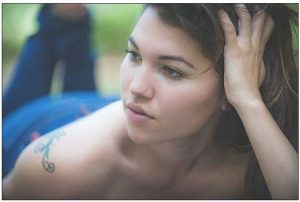
Fryda charges $100 per hour to model in full nude, implied nude, or with clothing.
PHOTOGRAPH BY DONALD JONES
Fryda and I met in August at Stepping Stone of California, which used to be the Lestat’s coffee shop by the Normal Heights sign on Adams Avenue.
“Mike, I went to your profile and I saw that you joined Model Mayhem some years ago (2015),” she said. “You didn’t sound like you were trying to get something out of me when you approached me.”
“But I did — I want your story,” I responded.
“It sounded like if you didn’t get it from me, you were totally fine,” she explained. “Then I went to go look at your work [online] and said to myself: ‘This is legit and he’s not bullshitting,’ and we are meeting in a public place [here at Lestat’s].”
Fryda doesn’t meet just anyone who reaches out to her — especially at night. “Initially, I don’t give them (photographers) my personal email or phone number right away,” she said. “I ask them: ‘What style are you looking to shoot; How many hours [will we shoot for] and what are you going to do with the photos?’ Then after they respond, if I want to pursue it: I’ll give them my email and maybe my phone number. This is a risky business and I prefer to talk on the phone before we meet up for the shoot, because it keeps me more comfortable. Then I’ll show up wherever I have to go: it could be at a hotel or a beach or wherever.”
Usually, Fryda charges $100 per hour to model in full nude, implied nude, or with clothing. She requires a two-hour minimum.
“Modeling began as a job,” Fryda said. “Now, it’s like a passion, and I have a lot of fun with it. I’m literally on top of everything, like all my bills …. and now I can share everything with my family as well, because I’m able to show them a lot of things I wasn’t able to before. It feels really good as a woman, and I’m more confident than I’ve ever been in my entire life.” On the Model Mayhem website, her details are listed: age, 26; height, 5’2”, ethnicity, Hispanic; compensation: paid assignments only; shoots nudes, yes.
“There’s photographers that do want the erotic implied adult nudes and there’s other photographers that like the fine art nudes that are more tasteful.”
On Fryda’s online model portfolio, her ‘About Me’ section reads in part: “I do not work for free, but I enjoy any opportunity to create. For all work, I strongly suggest emailing me and including a link to your Model Mayhem page…. Traveling for me has become immensely substantial! I’m always going to prioritize paid travel, so let me know where you want to see me go!”
On the Model Mayhem site, various photographers commented on Fryda’s portfolio, stating that they wanted to work with her; she has also received nine verified credits since she opened the account in September 2017.
“[Verified credits] do impact my business,” Fryda said. “People can be straight up and comment: ‘She bailed on me like three times.’ That’s like a bad review — kind of like Yelp. People won’t want to book you if they see that. It takes a lot for you to get a bad review.”
Verified credits allow you and the person that you’ve worked with to leave a comment about how the collaboration transpired. All nine of Fryda’s credits contained positive assessments; one read in part: “Lovely, natural and enthusiastic model. Easy to pose, she has some great ideas and is comfortable in her own skin. No BS or prima donna attitudes at all.”
Fryda admits that some models abuse the photographer’s hospitality and some don’t even show up to their scheduled photoshoots. “[Many professional photographers] cater to us because they want you to feel comfortable, they offer you something to drink and eat ….. the more comfortable we are, the better the photos will be.”
Clothes sell faster on a model
As a photographer for a vintage clothing business and for alternative lifestyle magazines, I can understand how positive energy translates into photos — and then to potential sales. Sometimes, prior to shooting a vintage clothing collection, I post a casting call on the Model Mayhem website, detailing the dates and times I will be available, location, style of photoshoot (catalog or editorial), and compensation (usually $12.5-$15 an hour). In my 20-plus years of selling online, I’ve noticed that clothing and accessories sell faster on a model, as opposed to when they are propped on a mannequin or hanger.
On November 5, I met with Carina, a 20-year-old San Diego State University student, to photograph some 1990s ugly sweaters and blouses created by the late
Koos van den Akker, and miscellaneous accessories. I needed to post the items on the eBay and Etsy platforms in time for the Cyber Monday rush. We photographed at the same cafe where I met Fryda two months earlier, because of the natural light that enters during the daytime. Also, the variety of wall colors and furniture upholstery textures would help frame the shots.
One article that Carina modeled was a cardigan sweater with a funky pattern reminiscent of the rayon shirts worn by Screech in the Saved by the Bell sitcom; the other was a navy blue multimedia looking blouse with paisley patterns throughout. Both items sold on November 11 for $100 and were shipped to United Kingdom.
“This project’s fun,” Carina said, “[and] different is always nice.”
Unlike Nikki the cosplayer, neither Fryda nor Carina place too much emphasis on their Instagram accounts. Fryda has only five posts and Carina has 21.
Carina said she likes to remain “low key” and that “showing off or getting too personal” on social media is not seen as likeable in her network of friends.
“I don’t really care about the fame,” Fryda said. “I care more about the experience.”
Fryda knows that if she posted her semi-nude or implied-nude photos on Instagram “on the regular,” she could build a serious following, maybe like San Diego model Julianne, who has 4.9 million followers on Instagram and was featured in the Reader in February 2018. Fryda’s IG is on private mode, which means she has to approve your account before you can follow and see her posts.
She began modeling around the summer of 2017 — shortly after she lost her San Diego job at a beauty supply shop, split up with her boyfriend of five years, and then flew out to Utah to stay with her relatives.
“In August (2017), I was looking for jobs in Salt Lake City, like at call centers,” she said. “Then I found these side jobs on Craigslist for quick money — like to model racy lingerie Halloween costumes.”
“It’s kind of weird right?” she laughed. “You figure I would’ve started modeling here in San Diego first.
“Then I met [Bob] in Salt Lake City. We did a test photoshoot, and after that, he left back to Michigan, where he resides.”
Bob (his name has been changed for the article) and Fryda kept in touch, and the two agreed that he’d manage her modeling gigs for a “ten percent cut.”
“I flew out to Michigan, and from there we were driving everywhere for model gigs,” Fryda said. “It was like a cross country road trip, and we would split the gas, hotel, and food. At first it was just me and him, then we met up with these two other girls. He would book my shoots, about three to four a week.”
Fryda said she was doing well on the road, but then things started to turn south when she noticed the other model and Bob giggling about “racist memes that they wouldn’t show me.
“And then, I wasn’t able to see these emails between Bob and the photographers,” she explained. “It was really shady to me, and it didn’t seem professional.”
Soon Bob started to act possessive and controlling toward Fryda. “I ended up leaving,” she says. “He was acting like a complete fucking asshole.” Fryda flew back to Salt Lake City, then eventually came back to San Diego.
“It kinda discouraged me, so I didn’t model for like a month,” she said. “Then I realized, ‘This [modeling] is a money-maker, and there’s no way I’m going to let this go. I made like $20-$30 thousand in the past five months. It’s still my first year, and I feel like I can do a lot better managing my money. I’m going to see a financial manager to help me with that.’”
Tricky runways
Certain models don’t mind if their responses are staged by others. Heather, a 19-year-old college student who messaged me on Model Mayhem in August, is one such. “Since most of it is contracted on what to post, when to post it, and what to say,” she said regarding her Instagram account, “it becomes extremely professional.”
Heather said she attends a California State University, but “I actually don’t name the [specific] school I attend for protection purposes. Due to having a high profile, I’ve had occurrences in the past that can interfere with my private life, so I don’t give that information out. ”
Heather has 37 posts on Instagram. Most are photos of her in bikinis. The remainder are of her walking or posing on runways.
“They (the companies that she represents) like to see that something even so personal to you can be controlled. It helps boost their sales and gives off the real-life touch of representation.”
A couple of months ago, she posted a photo of herself wearing an aqua floppy hat with a matching bikini top, and a tye-dye looking bikini bottom, and captioned it: “Freckles and a colorful coral kini, what more could a girl want (flower emoji).”
“Posting an ad with me in it is one thing,” she said, “but having me actually say: ‘HEY I LOVE THIS BRAND’ genuinely is another.
“I am currently represented by Agent Inc., a small agency. [Through an] app on my phone, I can update my portfolio, change my stats, apply to jobs sent to me by my agent, and work for bigger and better [projects].”
“How important,” I ask, “is it for you to maintain gigs, living in San Diego?”
“Without maintaining my gigs I would lose most of my stability,” she responded, “as this is a huge source of my income for bills, college, and my basic necessities such as food…. I charge $35 per hour and have a $250 day rate…. I am well-rounded now as a model, and although the gigs I’m doing are still building my portfolio, I no longer need to collaborate or do ‘time for photo’ gigs to learn what I’m doing.”
‘Time for photo’ or ‘TFP’ is a popular term or acronym in the modeling business which means the photographer will provide his or her service for free if the model is willing to work for free. Many in the industry do TFPs to build their portfolios; some TFP collaborations will consist of a whole team, including a wardrobe specialist, a hair-and-makeup artist, a videographer, a post-production editor, multiple models, photographers, and venue managers.
“I gained that experience over the course of a few years of not charging,” Heather said. “[Now,] for all print and commercial modeling, I have the same rate.”
Runway modeling, however, “can be a bit tricky,” she explains. “It really depends on what fashion week I’m walking for, along with designers. I’m actually flown to places a lot, and depending on what they can cover — such as hotel, flight, transportation, and food expenses — my actual compensation rate can change. So I may only make $70 from actually walking on the runway; however, I’ve had $2000 of expenses paid for, and I’ve walked in one of the top fashion shows. So it evens out.”
On Heather’s Instagram, she and three others (and their behind -the-scenes crew) were tagged to be on the cover of the January 2019 issue of Confidence Magazine. On her Twitter feed, she pinned photos of herself walking on the runways of the 2018 New York Fashion Week in September.
“My social media presence is extremely important, and I take pride in that,” she said. “It really is a huge source of my income, because that’s the number one thing clients look at nowadays besides your body. In the short run, it’s almost everything I do to make money; in the long run, my degree will be what maintains me.”
I had to ask if she’d pose in our “ugly sweaters,” because besides Carina, models who I reached out to on Model Mayhem site never responded.
“HAHA, I would absolutely love to shoot in ugly sweaters,” Heather said. “That fits my fun personality in a great way. I would charge you guys $50-$100 for that [photoshoot], just because of the drive time and the actual shoot.”
Pepper spray
Freelance modeling can be dangerous: in 2013, a Fox News report headlined “Women’s group hires detective to probe case of missing Colorado models” posted photos of two of the missing teens and captioned it: “Raven Furlong (l.) and Kara Nichols (r.) are both aspiring models with profiles on ModelMayhem.com and may have been abducted by a predator using the site.”
Internet Brands (which owns and operates ModelMayhem.com) spokesman Joe Ewaskiw was reported to have said in part in a written statement to Fox News: “While our policy is to fully cooperate with authorities if approached for assistance in an investigation, Model Mayhem has not been contacted by police authorities regarding either of the three recent disappearances in Colorado.
“Model Mayhem strongly believes that safety should be top of mind when doing anything online. The site offers detailed safety advice to help members understand what to look for when they are contacted by others.”
“This is risky business,” said Fryda. “I’ve got somebody always on call, I have my location on (on the cellphone), and I always tell somebody where I’m going to be at. I tell them: ‘This shoot’s gonna be two hours or four hours, and if you don’t hear from me by [say] 10:30, it’s too long.’ And I always have pepper spray on me.”
“It is an extremely rough business,” Heather said, “although the pictures and experiences are amazing, and I find them well worth it. It’s not a job for just anyone.”
Heather plans on walking at the “RAW San Diego presents: Reflect” event held at the House of Blues on January 19. “RAW showcases indie talent in visual art, film, fashion & accessories design, music, performance art, beauty, and photography,” says the website.
“It takes a lot of strength and individuality to know who you are,” she said. “To any other [prospective] models out there: research, learn, know modeling and the industry like the back of your hand, and make sure your confidence is high before going into any castings.”
What about male millennials?
I reached out to a few San Diego-based males from the millennial and post-millennial sects, but most did not respond.
One automotive-based brand owner said: “I hate talking on the phone” and declined to be in the article; another brand owner “clowned on me” and said: “IDFWU bloggers.” (IDFWU is an acronym for “I don’t fuck with you.”)
I did connect with Primee, now 27. He’s promoted San Diego hip-hop events since he was 17 — with rappers Drake, 2 Chainz, Waka Flocka Flame, YG and Mozzy — at AD Nightclub, On Broadway, The Observatory and Jolt’n Joes.
Primee’s got a silent partner who helps finance the events while Primee handles the promotions with his multiple Facebook, Instagram, and Twitter accounts, and also some of the backend stuff.
“We look into what artists are coming to town, or we see what venues are interested in what artists, and we reach out to them — my partner’s been doing it for way longer than me,” he said. I spoke with Primee on the phone in September; two months earlier, he had promoted the Suga Free rap concert at Diamond Jim’s in Chula Vista.
At the Suga Free event, a VIP booth and bottle was priced at $250.00; a table and champagne at $75; and general admission was $20.
“We find out if the venue has any nights available, and if we wanna do it ourselves — we do it ourselves,” he said. “Or if they are looking for the talent, we reach out to the talent.”
According to a 2014 Complex article titled: “How Much Does It Cost to Book Your Favorite Rapper?” 2 Chainz cost $85,000 and Drake cost $350,000-$600,000 to book. Primee, his partner, and others collabed and brought both to San Diego.
“We negotiate. Some artists don’t have the pull they do in other cities compared to San Diego because San Diego’s way different. They catch on too late. Like you can’t ask ‘What you are getting in the east coast or down south’ over here in San Diego.”
COVER PHOTOGRAPH BY HOANG PHAM

